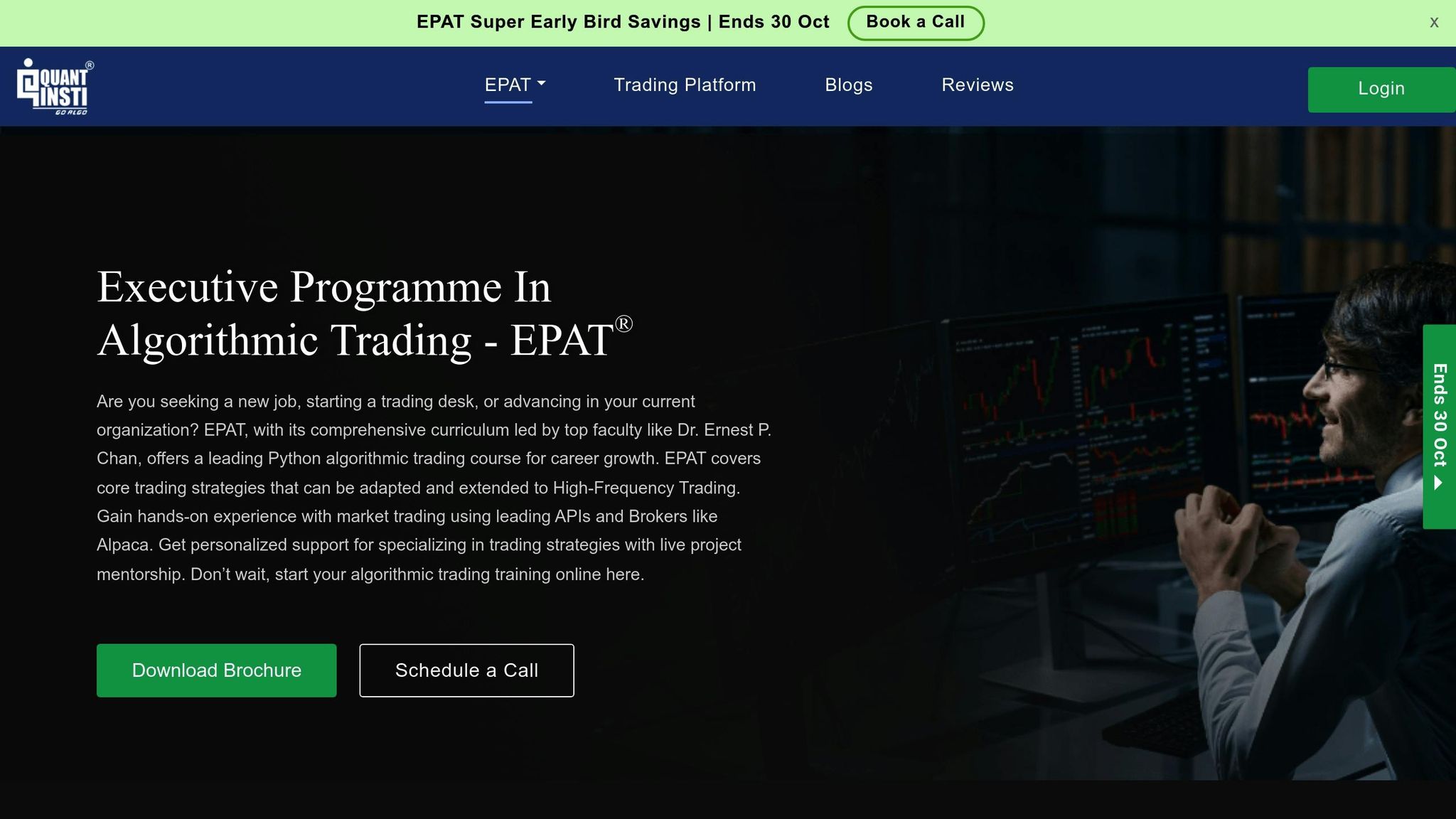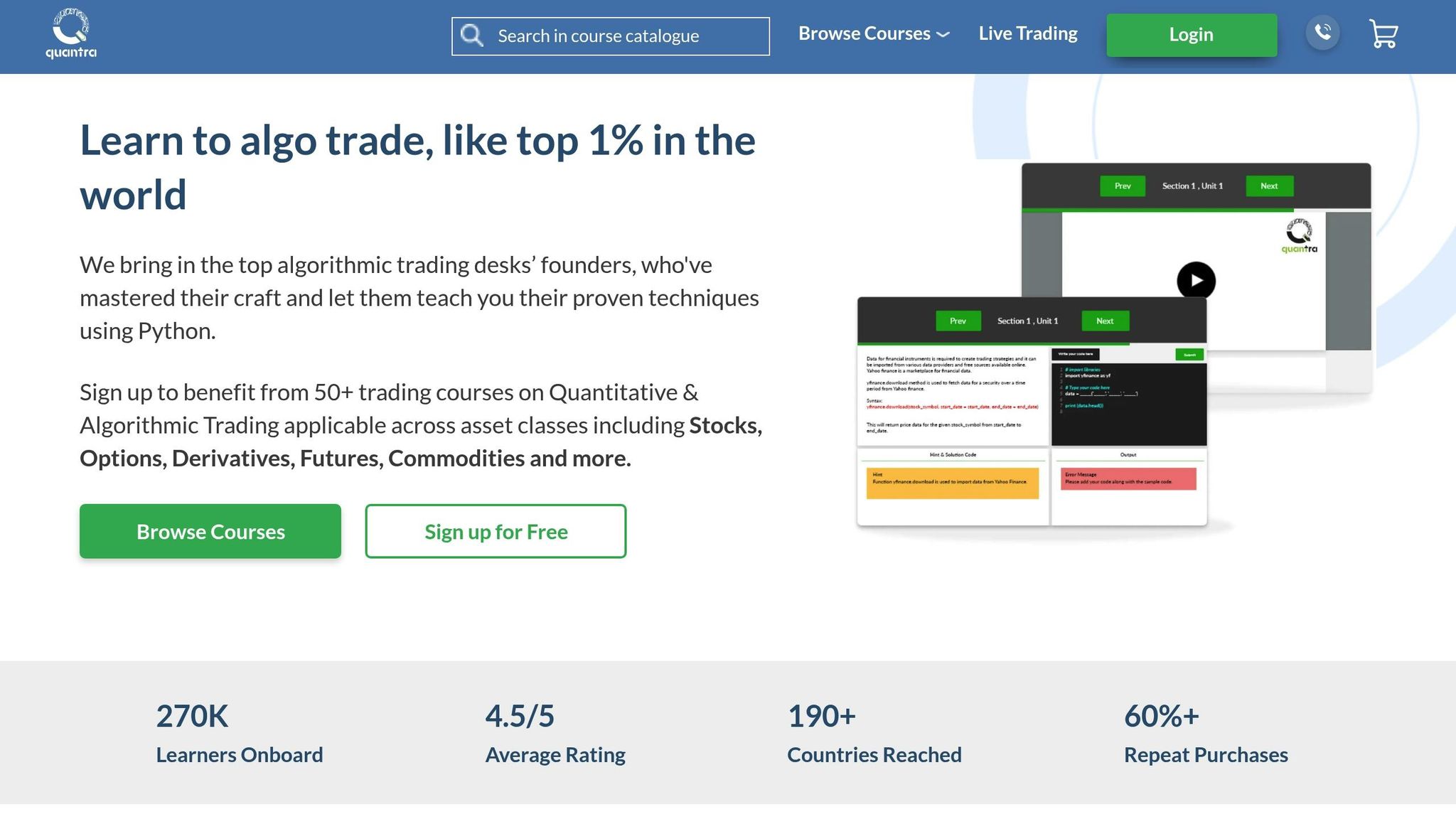Algorithmic trading is thriving in 2025, and Python remains the top programming choice for developing trading strategies. If you’re looking to learn algo trading with Python and earn a certificate, here are the top courses to consider:
- EPAT by QuantInsti: Advanced course for professionals, focusing on Python-based strategy building, backtesting, and integration with trading platforms. Great for career advancement but requires a significant time and financial commitment.
- Quantra‘s Beginner Track: Entry-level course for newcomers, covering Python basics and trading concepts. Affordable and self-paced, but may not suit advanced learners.
- DataCamp‘s Financial Trading in Python: Ideal for beginners in Python and trading, offering hands-on coding exercises. Limited in-depth trading concepts.
- Coursera‘s Trading Algorithms: University-level courses blending Python programming, trading strategies, and risk management. Includes project-based learning and certificates from top institutions.
Quick Comparison
| Course | Depth | Practical Focus | Certificate Value | Cost Range | Duration | Best For |
|---|---|---|---|---|---|---|
| EPAT (QuantInsti) | High | Strong | Industry-recognized | High | Long-term | Professionals |
| Quantra Beginner Track | Beginner | Moderate | Platform-specific | Low | Flexible | Newcomers |
| DataCamp Financial Trading | Beginner | Hands-on | Tech-focused | Low | Short | Python and trading novices |
| Coursera Trading Algorithms | Moderate to High | Strong | University-accredited | Medium | Moderate | Academic learners |
Choose based on your goals: beginners may start with DataCamp or Quantra, while professionals can opt for EPAT or Coursera for in-depth learning and career growth.
Learn Algorithmic Trading [Full Course] | Algorithmic Trading Workshop 2023
1. Executive Programme in Algorithmic Trading (EPAT) by QuantInsti

The Executive Programme in Algorithmic Trading (EPAT) is designed to equip professionals with both the theoretical knowledge and hands-on skills needed for Python-based trading. By focusing on practical tools and techniques, this program prepares participants to navigate real-world trading scenarios effectively.
Course Content
The program covers everything from building and backtesting trading strategies to executing them using Python. It also includes lessons on integrating these strategies with trading platforms and APIs to access live market data.
Practical Applications
Participants work on a self-directed project under the guidance of experienced mentors. This allows them to create and test their own trading algorithms using historical market data, providing invaluable hands-on experience.
2. Algorithmic Trading for Beginners Learning Track on Quantra

The Algorithmic Trading for Beginners Learning Track on Quantra is designed to help newcomers grasp the basics of algorithmic trading. It’s a great starting point for those interested in Python-based trading strategies.
What You’ll Learn
This course dives into essential concepts, industry-specific terminology, and fundamental Python programming skills. The focus is on equipping learners with knowledge they can put into practice right away.
Hands-On Experience
The program prioritizes practical learning, guiding participants through strategy implementation to connect theoretical knowledge with real-world trading situations.
Up next, we’ll take a closer look at another course offering fresh perspectives on algorithmic trading.
3. Financial Trading in Python by DataCamp

DataCamp’s course, Financial Trading in Python, focuses on using Python for practical applications in financial trading. While specifics about the curriculum, projects, certification, pricing, and course length aren’t provided here, you can find the most up-to-date details directly on DataCamp’s website. This course could be a great opportunity to gain hands-on experience in trading with Python.
4. Trading Algorithms on Coursera

Coursera collaborates with top universities to deliver algorithmic trading courses that combine academic depth with real-world applications. These programs are a solid choice for those looking to gain university-level knowledge in algorithmic trading while staying grounded in practical skills.
Course Content
The courses typically dive into quantitative finance fundamentals, quantitative analysis, and Python programming. Students learn to craft trading strategies using historical data, set up backtesting frameworks, and grasp essential risk management principles. Many courses also explore machine learning in finance, portfolio optimization, and market microstructure.
Hands-on programming assignments are a key feature, allowing students to work with real financial datasets. The curriculum transitions from introductory Python programming for finance to advanced topics like high-frequency trading algorithms and automated trading systems.
Practical Applications
A standout feature of Coursera’s algorithmic trading courses is their focus on project-based learning. Students often undertake capstone projects where they design Python-based trading systems from scratch – covering everything from strategy development to backtesting and performance analysis. These projects include analyzing market data, spotting trading opportunities, and building automated trading solutions.
The practical work extends to using live market data feeds, understanding order execution, and connecting systems to brokerage APIs. Students also gain hands-on experience in troubleshooting algorithms and ensuring their data remains accurate and reliable.
Certification Value
Coursera certificates, created in partnership with esteemed institutions like Stanford University and the University of Washington, are well-regarded in the professional world. They can be shared on platforms like LinkedIn to boost your profile.
These certificates include verified completion records, showcasing your ability to handle rigorous coursework. Some programs even offer the option to earn university credits, which is particularly useful for professionals aiming to formalize their skills in quantitative finance. This recognition highlights the growing demand for Python-based trading expertise in the industry.
Cost and Duration
Courses range from $39 to $79 per month, while specializations cost $49 to $99 monthly. Individual courses typically last 4–8 weeks (requiring 5–10 hours of weekly effort), whereas specializations take 3–6 months to complete. Financial aid is available for those who qualify, making these courses more accessible. Additionally, the self-paced structure allows learners to adjust their schedule based on their experience and availability.
Course Comparison: Pros and Cons
When it comes to algorithmic trading courses, each option brings its own set of strengths and weaknesses, catering to a variety of learning goals, budgets, and career ambitions.
EPAT by QuantInsti stands out for its in-depth curriculum and strong reputation within the industry. With a focus on quantitative techniques and a robust alumni network, it’s a great fit for those aiming to deepen their expertise in the field. However, it requires a considerable time commitment and comes with a higher price tag.
Quantra’s Learning Track offers an accessible, self-paced structure at a lower cost. Its beginner-friendly content is ideal for those just starting their journey in algorithmic trading. That said, traders with more experience may find the material too basic and might need to seek advanced strategies elsewhere.
DataCamp’s Financial Trading course emphasizes Python programming with hands-on coding exercises, making it a solid choice for beginners in both trading and programming. However, it doesn’t dive deeply into advanced trading concepts, which could limit its appeal for those looking for more comprehensive training.
Coursera’s trading algorithms courses, developed in partnership with universities, strike a balance between academic rigor and practical application. The project-based learning approach provides a practical edge, but the content can sometimes lean more toward theory, which may not suit everyone.
| Course | Content Depth | Practical Focus | Certification Recognition | Relative Cost | Duration | Best For |
|---|---|---|---|---|---|---|
| EPAT (QuantInsti) | Extensive | High | Highly regarded in industry | Premium | Extended | Professionals seeking expertise |
| Quantra Learning Track | Beginner-friendly | Moderate | Platform-specific | Affordable | Short to moderate | Beginners at their own pace |
| DataCamp Financial Trading | Python-focused | Hands-on | Recognized in tech circles | Economical | Short | Newcomers to programming |
| Coursera Trading Algorithms | Academically driven | Project-based | University-accredited | Mid-range | Moderate | Learners seeking academic grounding |
Choosing the right course depends on your skill level and career goals. If you’re new to programming, DataCamp is a great starting point. For those seeking advanced quantitative skills, EPAT is worth considering. Quantra offers an approachable introduction to trading, while Coursera provides academic credibility that could enhance your professional profile.
This comparison lays the groundwork for selecting the course that aligns best with your aspirations.
Final Recommendations
When selecting a course, think about your current skills, career goals, and budget. Each option has its strengths, so choose one that aligns with where you are now and where you want to go.
If you’re completely new to programming and trading, DataCamp’s Financial Trading in Python is a great place to start. It offers interactive coding exercises that build your Python skills while introducing trading basics – all at an affordable price.
For professionals aiming to make a mark in quantitative finance, the EPAT course by QuantInsti is worth considering. Its in-depth curriculum and strong alumni network make it a standout option. While it requires a higher investment, it’s widely respected in the industry and can significantly enhance your career prospects.
If you prefer learning at your own pace, Quantra’s Learning Track could be a good fit. Its flexible, self-paced format is perfect for busy schedules, allowing you to tailor your learning experience to your needs.
For those aiming to strengthen their academic foundation, Coursera’s Trading Algorithms courses are a solid choice. These courses, developed in partnership with universities, blend theoretical knowledge with practical skills, making them ideal for professionals who want both academic credibility and hands-on experience.
To get the most out of your learning journey, consider a step-by-step approach. Start with a beginner-friendly course like DataCamp to build your Python skills. Then, as you progress, move on to more advanced options like EPAT or Coursera to deepen your expertise in quantitative finance or academic theory. This way, you can gradually enhance your skills while ensuring your investment in learning pays off.
Finally, keep in mind that the value of certifications depends on your career path. For roles in quantitative finance, EPAT is highly regarded. On the other hand, Coursera’s certificates, backed by university partnerships, are well-suited for broader roles in financial services.
FAQs
What sets the EPAT course by QuantInsti apart from Coursera’s algorithmic trading courses?
The EPAT (Executive Programme in Algorithmic Trading) by QuantInsti is known for its detailed curriculum and strong emphasis on Python programming tailored for algorithmic trading. Designed for dedicated learners and professionals, this program offers a well-structured learning journey guided by industry experts. Completing the course also earns participants a certificate that holds significant recognition within the trading industry.
On the other hand, Coursera offers algorithmic trading courses like Trading Algorithms, which are generally shorter and aimed at a wider audience. These courses focus on essential skills such as financial analysis and technical trading strategies but don’t dive as deeply into advanced or specialized topics as EPAT does. While both options have their merits, EPAT is better suited for individuals looking for a more thorough and professional-level education in algorithmic trading.
What are the costs and time commitments for algo trading courses, and which ones provide the best value?
The price and duration of algorithmic trading courses can differ significantly based on the program you choose. More in-depth options, like professional certifications, might span up to six months and cost several thousand dollars. On the other hand, beginner-friendly courses are often shorter – just a few weeks – and come with a more manageable price tag.
What you choose should align with your goals. If you’re planning to build a career in algo trading, it might make sense to invest in a comprehensive, hands-on course taught by experienced instructors, even if it’s more expensive. But if you’re a beginner looking to dip your toes into the world of Python and trading concepts, shorter and more affordable programs can give you a solid starting point without requiring a huge time or financial commitment.
Are certificates from Python-based algo trading courses valued by employers, and how can they benefit my career?
Certificates from Python-focused algorithmic trading courses can be a great addition to your resume, but their value largely depends on who offers the course and their standing in the finance world. Courses led by seasoned experts or backed by reputable institutions often hold more credibility.
These certifications can boost your career by teaching you sought-after skills like Python programming, quantitative analysis, and algorithmic trading strategies. Many programs also feature practical projects and training with tools commonly used in the industry, giving you a solid foundation for roles in trading, quantitative analysis, or fintech.
![Best Algo Trading Courses with Python & Certificates [2025]](/_next/image?url=https%3A%2F%2Fwordpress.quantvps.com%2Fwp-content%2Fuploads%2Fimage_2a12de0e02b9e05b34c014285957695f.jpeg&w=1080&q=75)







